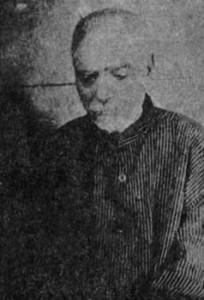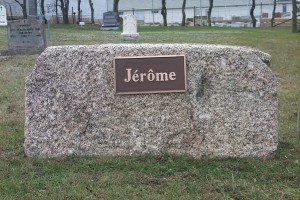
|
|||
"Jerome" - Mystery Man of Sandy Cove Nova Scotia
Source :http://en.wikipedia.org/wiki/Jerome_of_Sandy_Cove
Jerome is the name given to an unidentifiable man discovered on the beach of Sandy Cove, Nova Scotia, on September 8, 1863. He was found with both legs cut off to stumps, and when questioned by locals he said very little, suggesting he did not speak English. When asked for his name he mumbled something that resembled 'Jerome', and so that was what he became known as. Discovery He was found by an 8-year-old boy named George Colin "Collie" Albright, and brought to the Albright home in the village of Digby Neck to be nursed back to health. Jerome had both legs amputated just above the knees, with evidence that it had been done by a skilled surgeon. The stumps were only partially healed and still bandaged when he was found. He was also suffering from cold and exposure. Many people eager to know more about him visited his sick bed, and through this it was discovered that he could not (or did not want to) understand French, Latin, Italian, or Spanish. He apparently shunned the attention of these curious onlookers, growling like a dog at unwanted guests. The man's hands were noted as being too soft for him to be a manual labourer, and he was described as being Mediterranean in appearance. The Albrights struggled to support another mouth to feed, and Jerome was passed from house to house for a while until the mainly Baptist community of Digby Neck decided from his appearance that he must be a Catholic, and sent him to the neighbouring French community of Meteghan. The government of Nova Scotia also voted a special stipend of two dollars a week to support Jerome. The community still trying to break his relative silence, Jerome was sent to stay with Jean Nicola, a Corsican deserter and speaker of several languages. Nicola could not get him to talk, but Jerome stayed in the Nicola home for 7 more years, becoming a favourite of the ladies of the household, Jean's wife Julitte and his stepdaughter Madeleine. After the death of Julitte Nicola, her husband returned to Europe and Jerome went to stay with Dedier and Zabeth Comeau in St. Alphonse, near Meteghan. The Comeaus used Jerome's relative fame to their advantage, charging admission fees to see the mystery man, living well on this and the government stipend. But Jerome did not seem to mind, and stayed there for the rest of his life, which ended on April 15, 1912.
It was early morning of September 8, 1863. A Sandy Cove fisherman gathering rock weed along the shore noticed a dark figure along side a big rock on Bay of Fundy beach. As the fisherman got closer he saw the huddled form of a man. Both legs had been amputated just above the knees and beside him was a jug of water and a tin of biscuits. His legs had, obviously, been amputated by a skilled surgeon and the stumps were only partially healed and bandaged. The man was also suffering from cold and exposure. The fisherman recalled a ship the day before passing back and forth a half mile off shore in St. Mary's Bay. It was surmised the man must have been brought in from the ship after dark and left on shore. The castaway was carried to the home of Mr. Gidney in Mink Cove where he was wrapped in warm blankets and given hot drinks. Through the moaning and muttering only one word was understood, "Jerome". So they called him by this name. Jerome's hands weren't calloused and his clothes were cut from fine cloth. Speculation up and down the bay soon led many to believe he had attempted a mutiny and was punished by the amputation. Others suggested he was tossed from a pirate ship. Most thought, however, that he was heir to a fortune and had been crippled and cast away to make way for someone else seeking his inheritance. This story is about a less well known but certainly more mysterious Jerome. He was discovered on the beach at Sandy Cove, Digby Neck, Nova Scotia by an eight-year-old boy named George Colin Albright, or “Collie” as he was popularly known. Young Collie was doing a little beach combing when he spotted something odd perched in the sand. Closer inspection revealed a swarthy young man, minus both his legs. Collie ran off, trying to get help, but had a hard time making himself believed. Eventually two farmers accompanied him to the shore, and when they realized he was telling the truth, rescued the castaway. Thus started a controversial mystery which has not been completely solved to this day. The young lad’s hands were soft, suggesting he had never had to do manual labor, and soon speculation rose that he may have been a wounded officer of some European war, or perhaps even the Civil War which raged in the United States at the time. Some thought he might have been a royal embarrassment to some European royal house, and had been unceremoniously mutilated and dumped on a far-off shore. Questioning the lad provided little additional information as he did not seem to speak English. Half dead from hypothermia, the young man was nursed back to health in the Albright home and received many visitors, including newspapermen, local clergy and scholars. Although swarthy and Mediterranean in appearance he did not seem to understand French, Latin, Italian, Spanish or any other language. He appeared to shun the attention he received and was a surly house guest, showing gentleness only to small children with whom he loved to play. He was morose, growling like a dog at unwelcome visitors. The Albright’s house guest was a major burden for a poor fisherman to support, and after going through several different homes, the good Baptists of Digby Neck decided such a swarthy fellow must indeed be Catholic and shipped him off to the neighboring French community of Metghan, where he would live out the rest of his days. Indeed, the government of Nova Scotia voted a special stipend of two dollars a week to support Jerome. Jerome ended up ensconced in the home of Jean Nicola, a Corsican deserter who was known locally as “the Russian”, probably because of the few words of that language he had picked up in the Crimea. Though Jerome and Jean were constantly at odds, the mysterious man soon became a favorite of Nicola’s wife, Julitte and his stepdaughter, Madeleine. Jerome spoke very little, but over the course of time he revealed in fragmented and hesitant speech he had come over on a vessel named the Columbo and that he was originally from Trieste. After the death of Julitte, Nicola returned to Europe and Jerome found himself in the keeping of Dedier and Zabeth Comeau. His two dollar weekly stipend came in handy to support the Comeau’s burgeoning family, which included a son studying for the priesthood. As well, there was no shortage of curiosity seekers who were willing to pay admission to see Jerome, who many still believed to be European royalty. Despite his exploitation, Jerome was content to play and enjoy the company of the Comeau children. On one occasion two mysterious ladies visited and asked to speak to Jerome in private. They spoke in hushed tones, and as they were leaving they said, “He is well here. Let him be.” As time passed, more clues materialized as to the origin of the stranger. Word came that in 1859 a young foreigner wandered into the town of Chipman, New Brunswick, across the bay from Nova Scotia. The young stranger somehow managed to fall through river ice but was miraculously saved when discovered by two brothers. Eventually, he developed gangrene in both legs and had bilateral amputations performed by Dr. Harry Peters. Here he became known as “Gamby”, probably because on wakening he kept calling for “gamba”, Italian for “legs”. Gamby proved a burden for the good people of Chipman as indeed he did to the good citizens of Digby Neck. It would appear a passing schooner captain was paid handsomely to transport the disabled man to friendlier climes. The schooner captain appears to have simply crossed the Bay of Fundy and dropped him off on the beach at Sandy Cove. Putting our clues together, and checking shipping records, it would appear that Jerome had come over an a vessel called the Columbo which sailed from Europe, landed in Halifax and went on to New Brunswick where he jumped ship. After his unfortunate accident, he must have been extremely traumatized to find himself waking, minus his legs, in a place where nobody spoke his language. Indeed, his inability over many years to learn French or English — or, indeed, to have been unable to communicate in his native language — would suggest that he may have suffered a stroke affecting his speech centers. This could have occurred due to hypA simple stone in the cemetery at Meteghan, Digby Co., Nova Scotia which marks the final resting place of the man known only as Jerome.othermia, arrhythmia upon rewarming from hypothermia, or blood loss from his amputation. Interestingly, despite his limited speech, he was occasionally heard late at night singing beautifully in a foreign language. Dr. Oliver Sacks has described this very phenomenon in his book Musicophilia. Jerome’s emotional difficulties, which were to last his lifetime, no doubt reflected the effects of post-traumatic stress disorder (PTSD), a condition which occurs after extreme life stressors, subsequently marked by anxiety, depressed mood, disrupted sleep and limited ability to relate to others. Jerome spent a total of 49 years in his involuntarily adopted home of Nova Scotia before finally passing away on April 15, 1912, the very day the RMS Titanic went down.. Jerome seemed fond of children. He spent most of his time with children and seemed to enjoy watching them play. Jerome conducted himself with dignity and when offered money he would appear humiliated. However, he would accept gifts of candy, tobacco and fruits. He was wary of strangers but in appearance and manner was a gentleman and easy to care for. He got so he could move nimbly on his stumps but sat most of the time. It was soon realized that Jerome was here to stay so the Provincial Government contributed to his keep, $2.00 per week.  Sailors of many nationalities were brought to Jerome to see if he would speak their language. He still did not speak but some believed that through his expressions he was familiar with European languages. He also became very angry when any such visitor mentioned Trieste. Some believed him to be from noble stature and that he once must have been an officer. From his looks and complexion they felt he must be French or Italian. Jerome was taken to the home of John Nicholas in Meteghan, who spoke several European languages. Mr. Nicholas tried to break Jerome's silence but failed. Jerome spent 7 years with Mr. Nicholas and the remaining 42 years of his life with Deider Comeau and family at Alphonse de Clare. For the next seven years Jerome lived with Nicholas family and it was soon concluded that he kept silent not because of some physical limitation, but for another reason known only to him. When caught off guard Jerome would answer questions. Once when asked the name of his home, Jerome answered "Trieste" which is a city in the Northern part of Italy. He also answered "Columbo" when asked the name of his ship. After being tricked into speaking, Jerome would become furious and shut himself up in his room. Stories circled the town about Jerome's life, his silence and the reasons why he was deliberately left on the shore. Although Jerome never had a very good relationship with adults, he got along very well with the local children. They would visit him, bring him candy and eventually he became quite fond of the sweet gifts. Later, Jerome moved to Saint Alphonse to live with the family of William Comeau and while there, he received a visit from two strange ladies. The ladies asked if this was where they could find the man with the amputated legs. Once the women were in the house, Jérôme led them into his room and a long conversation followed in which he took an active part. The family listened outside the door, but could not understand the language being spoken in the other room. After the meeting, the two ladies left the house without another word. They then conversed outside and seemed to be of the impression that Jérôme was being well taken care of and they were to leave him where he was. The ladies never returned. Another strange occurrence added more mystery to this silent man's story. Charles, William Comeau's son, had gone to Boston for work. While there, two women came to visit him from the Southern United States. They had read in the papers stories about a man with amputated legs who was found in Nova Scotia. The woman proceeded to tell him that the unfortunate man's name was Jeremiah and that he came from Alabama. They handed him a letter to give to "Jeremiah" and asked him to deliver it for them. Upon his return to Clare, Charles did as he had promised and handed the letter to his father's border. Jerome took the letter looked at it from every angle and then threw it into the fireplace. The family was shocked and disappointed with this and the story of "Jeremiah" was never known. The Comeaus used Jerome's relative fame to their advantage, charging admission fees to see the mystery man, living well on this and the government stipend. But Jerome did not seem to mind, and stayed there for the rest of his life, which ended on April 15, 1912. Many attempts were made to find an identity for this mystery man but none succeeded. Jerome died in April 19, 1912 and took with him the secret of his mutilation and of his mysterious arrival on the Bay of Fundy shore.  Earlier this year a large stone marker bearing the name Jerome was unveiled in the Meteghan parish cemetery where he had been buried. comments powered by Disqus Submit News/Videos/Links | Discuss article | Article Link | More Unsolved and Unexplained Mysteries |
More can be addded on request. Direct your requests at vinit@theunexplainedmysteries.com
